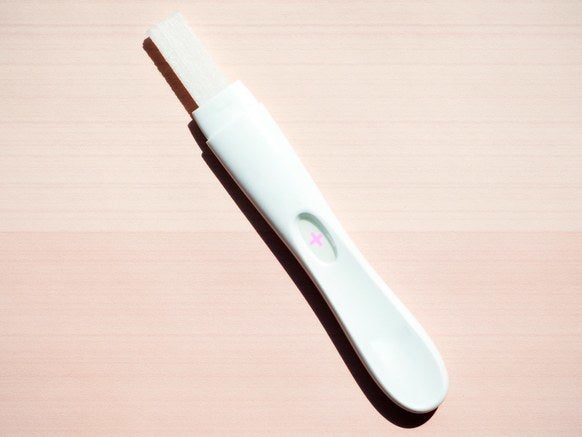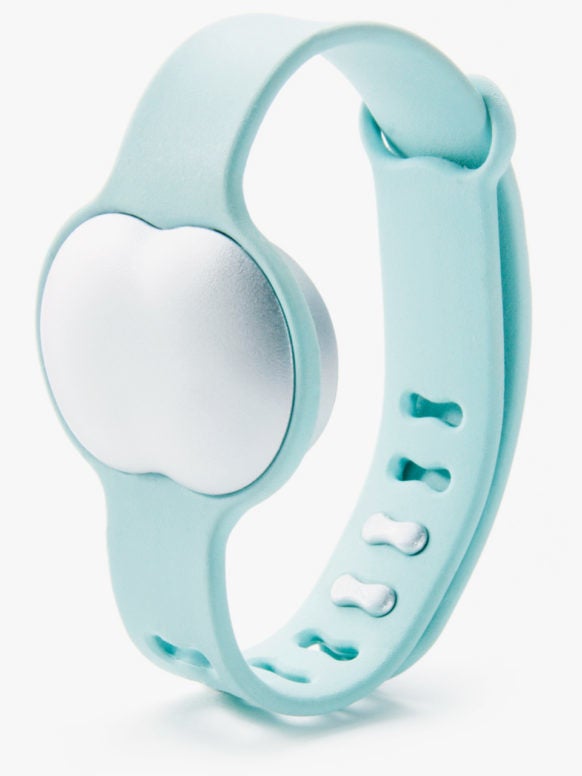By Adrienne So for Wired.

Every morning, I pee in a cup. Before I do anything else — pick up my toddler daughter, pet my dog, even fully open my eyes — I collect a sample of urine, soak a swab in it for fifteen seconds, stick the swab in a machine, and wait five minutes for a beep.
Nothing can make you more obsessed with science and technology than the biological imperative to reproduce. And nothing makes fulfilling that imperative more difficult than your own body. For the first two weeks of the menstrual cycle, a woman’s ovary grows an egg. When the egg is mature, it leaves the ovary and travels through the fallopian tube to the uterus. This process is known as ovulation.
You’re most fertile in the two to three days before ovulation. But pinpointing that window is a difficult — and, OK, sometimes gross — affair. Methods like my fertility monitor or ovulation predictor kits rely on detecting estrogen and luteinizing hormone in urine. A sudden rise of LH triggers ovulation.
“Nothing can make you more obsessed with science and technology than the biological imperative to reproduce.”
Many women find themselves in a stick-peeing frenzy, timing bathroom breaks at work to try to catch that elusive LH surge, which could occur anywhere from 10am to 8pm after day ten of your menstrual cycle.
Other methods, like taking your basal body temperature, mean that you have to buy a special thermometer and take your temperature at the exact same time every morning, before you’ve even gotten out of bed. A rise in BBT signals that you’ve ovulated. But you can only see the rise after you’ve ovulated, and not before, which defeats the purpose. And of course, there’s my urine-swab machine, the fertility monitor, which uses your first morning urine over the course of one or two weeks to detect the LH surge — and good luck if you forget and go to the bathroom before collecting a sample.
The Centers for Disease Control reports that one in eight couples has trouble conceiving or sustaining a pregnancy, due to age, health issues or other factors. That means the market is wide open for anything that will bring the technology of this tedious, anxious process a little farther into the 21st century. Apps like Glow and Apple’s own Reproductive Health kit in iOS make it easier to record, visualize and aggregate large amounts of data.
But for each individual user, touting these apps as an advance in ovulation prediction is like buying a FitBit that requires you to count your steps manually. I was more interested in seeking out devices that would make the process of collecting that data easier.
Made to Measure
One of the most exciting advances in that direction is this year’s release of the Ava bracelet, otherwise known as the “fertility FitBit”. A team of researchers, which includes data scientists, wearable tech experts, and a medical advisory board, studied the existing literature on the changes that the estradiol (a form of estrogen) and luteinizing hormone surges precipitate in the body when you ovulate.
The Ava team developed a sensor that could record data from nine different parameters such as body temperature, resting pulse rate and heart rate variability when worn over the course of a night. An algorithm uses this data to predict the five most fertile days.
A year-long clinical trial at the University Hospital of Zurich confirmed the team’s findings that the Ava is 89 percent accurate at predicting five fertile days per cycle, but with a sample size of 41 women over the course of year, it’s hardly conclusive.

The research team is currently conducting another, larger study, following 200 women over the course of six months to further fine-tune the algorithm and add more data use cases. But despite the fact that they’ve yet to publish their research (they’ve presented it at the Swiss and German ob-gyn conferences and to the American Society of Reproductive Medicine), Ava’s current two- to three-month waiting list speaks to the need for a device like it.
“For us, the convenience is important,” said Ava VP of data science Lisa Falco. “[The Ava] also reacts earlier. You can be a bit more relaxed about it.” Measuring nine parameters also makes the Ava’s predictions more robust, rather than relying on a urine or temperature test that uses one measurement.
After testing the Ava for two weeks, I can testify that it is much, much easier to use than a fertility monitor or OPKs. You don’t have to put off using the restroom within a certain time frame, or manually record data in an app. Instead, you take off the bracelet in the morning, plug it in next to your iPhone at your convenience, and it wirelessly syncs within seconds.
The Ava’s one major drawback is that at the moment, it works only for women with regular menstrual cycles between 24 and 35 days. Women with irregular cycles or those with polycystic ovary syndrome would see little benefit. “This is where we want to become stronger,” says Falco.
Signs of Life
Another device that was released this year, the Knowhen, is effective for women with irregular cycles or medical conditions. The Knowhen is a pocket-sized personal microscope that detects ovulation through a process called ferning.
Each morning, you place a drop of saliva on the lens. After it dries, you look at the pattern through the microscope. The rise in estrogen that precedes ovulation also triggers a rise in sodium chloride in your saliva. When you start the ovulation process, the salt crystallizes into a distinctive fern pattern, visible through the lens.
“I firmly believe that infertility is not an epidemic. It’s a lack of knowledge,” Knowhen founder and CEO Helen Denise said. “Sometimes I meet women who say that something is wrong with the microscope, that they never see the ferning. It’s not the microscope. It’s you. If you have PCOS or a thyroid problem, we can help you diagnose it even earlier or see a doctor in time,” before spending months in fruitless attempts at conception.
People have been using ferning microscopes for a long time, but Knowhen is product that hopes to make the technique more accessible. Placing a drop of saliva on the pocket-sized lens and waiting for it to dry is a simpler and slightly more sanitary method of testing than peeing in a cup while still half-asleep. Timing is also less of an issue. But the Knowhen is also prone to user error. You have to remember to use a spit drop first thing in the morning, before eating or drinking. Failing to clean the lens beforehand, or using a spit drop that has bubbles, can also confound the results.
We’re Due
What’s clear is that, while much of the market has been focused on improving access to reproductive technologies like in-vitro fertilization and egg freezing, there is plenty of room in a different fertility tech space as well.
In an age where an attractive, waterproof watch can monitor our light and deep sleep cycles and receive texts, it is absurd that so many women rely on technology from the 1970s for such an important, intimate process. Even if you discount the financial gains, there are other tremendous rewards.
“We had this really big one success story of one of our users,” Falco said. “According to the calendar method, she wouldn’t have been in the fertile window. She used the Ava one day earlier than she thought, because her husband was going away somewhere. We found out [she was pregnant] before her husband did.”
More from Wired:

